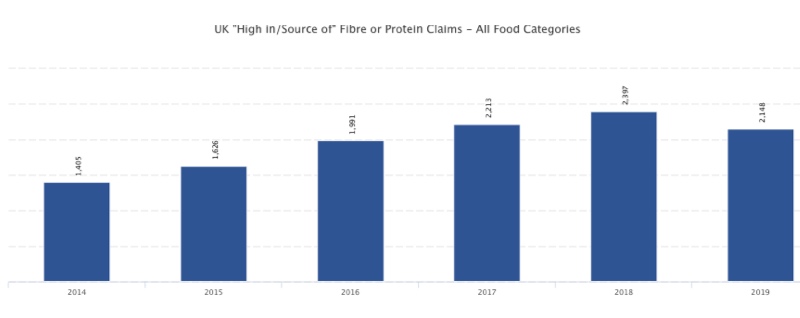Developing healthy foods today is as much about proactively adding functional ingredients for nutritional enhancement as it is about removing fat, sugar, and calories.
Product launches containing alternative plant-based ingredients increased 62% globally between 2013-2017, and "high in protein" front of pack claims experienced a 27% rise in 2016/17 alone.1
Food companies now understand, however, that capitalising on the fibre and protein market trends is not achieved by the front of pack declarations. The benefits of fortification extend beyond labelling.
What does the market say?
There is certainly a market appetite for protein and fibre fortification. Consumers have more information at their fingertips than ever before, and they expect clean, sustainable, ethical and healthy products, all contained within a convenient and good value product.
Five years ago, protein and fibre claims were generally reserved for sports nutrition or specialist sectors. Now the market has evolved for these to be far more prominent in more conventional sectors.
As a result, the incidence of the front of pack "Source of/High in..." fibre or protein claims has grown rapidly, with the number of product launches advertising these claims almost doubling in the last five years.

Fig 1. Requirements & definitions for fibre and protein claims
Benefits of protein fortification
As well as being an eminently marketable ingredient, protein has always been a fundamental building block in our diets. The role protein plays in tissue growth and repair is well known, but proteins provide an array of additional health benefits, often ones that consumers are unaware of.
Protein is the most satiating macronutrient. It increases satiety more than the equivalent amount of calories as either fat or carbohydrate. As a result, protein consumption (especially plant protein consumption) has been earmarked as a crucial way to tackle the obesity crisis. "Fuller for longer" is now a key message in the development of healthy products.
How does it work?
The feeling of fullness is due to the release of specific hormones in the gut sent to the central nervous system (CNS).
While eating, the brain receives signals as the stomach expands, and sensory receptors identify changes in pressure on the stomach walls. As more food is digested and absorbed, more hormones are released to the brain.
Satiety is controlled by a number of factors after eating high levels of protein, including:
- Slowing digestion: protein is crucial in "gastric emptying" as it is the main stimulus for hormone. It is these hormones (CCK and PYY) that delay gastric emptying, giving much longer satiety effects; resulting in increased nutrient absorption and efficient digestion.
- Increased energy expenditure: protein induces a higher metabolic response compared to other macronutrients. This results in greater energy expenditure, in turn altering energy balance and aiding weight loss.
- Increased levels of amino acid plasma: increased levels of amino acid concentrations brought about by a high protein diet increase feelings of satiety. In this scenario, a signal is sent to the brain, acting as a satiety signal to prevent a further increase.
- A change in gluconeogenesis: this refers to the production of glucose from particular noncarbohydrate carbon substrates. A high-protein diet improves glucose synthesis and subsequent breakdown efficiency, therefore increasing satiety.

Manufacturers need a partner that appreciates the different flavour and functional aspects
to ensure the solution works for them
Fibre as a prebiotic
Increasing levels of fibre give lower-calorie products, significant health benefits, and useful product functionality.
Partial or complete fermentation of fibres occurs in the large intestine in the body; this only occurs to carbohydrates that are not digested or absorbed in the small intestine.
The fermentation of the fibre by the bacterial microflora boosts the activity of health-promoting bacteria in the gut, meaning that the fibre is acting as a prebiotic. As the short-chain carbohydrates are unable to be digested, they are fermented and converted into short-chain fatty acids and gases.
Consuming more fibre is proven to have health benefits in the following areas:
- Reducing cardiovascular disease/heart disease and strokes
- Improving gastrointestinal health and can help reduce the chances of certain cancers
- Digestive health benefits; increased faecal bulk, which can give a faster transit time and prevent constipation
- Aiding type 2 diabetes management by controlling insulin sensitivity and GI control
- Soluble fibre (beta-glucans and pectin) can help reduce blood cholesterol
- Increasing satiety and aids in weight control
- Lowering blood pressure
Satiating effects
Like protein, increasing fibre consumption has significant impacts on satiety. Not only does fibre provide satiating effects, but it also has a very low calorific content with just 2 kcal per gram.
By comparison, protein gives 4 kcal per gram, fat 9 kcal per gram, and carbohydrate 4 kcal per gram.
Fibre affects satiety in both physical and sensory aspects. Soluble fibres can provide satiating effects due to the more viscous structures they give. In simple terms, the higher the viscosity in the stomach, the slower the gastric emptying is, hence there is a slower release of nutrients. This also helps with increased vitamin and nutrient release.
Moreover, the thicker a product is, the longer it stays in the mouth, making the cephalic phase response stronger due to better sensing of nutrients on the tongue.
The cephalic phase of digestion is the gastric secretion that occurs even before food enters the stomach. In other words, there is an expectation that when you eat thicker and creamier food, it will be more satiating and result in you eating less of it.
Another way that soluble fibres can help with increasing satiety is when they are actually in the stomach. When these gums gels reach the acidic environment in the stomach, they slow the rate of gastric emptying. In turn, this also slows the release of hormones that control hunger and satiation during digestion.
The longer it takes for the stomach to empty, the longer these hormones will be released, increasing satiety, and controlling energy intake.
How easy it is to fortify?
There is more to enrichment than simply dropping in any protein. Proteins very often have significant effects on the texture and flavour of a product, and therefore the correct functional protein has to be selected for each individual application.
For manufacturers to fortify successfully, they need to work with a partner that has a diverse range of proteins, and one with the on-hand technical support to appreciate the different flavour and functional aspects and ensure the solutions works for them.

Fig 2. The Growth of High in/Source of Fibre or Protein. Credit: Innova Market Insights
R&D Manager at Ulrick & Short, Danni Schroeter, backs this up, stating: "The end goal is to be able to make protein claims and improve nutritionals without people knowing is it any different to the standard product."
Schroeter says Ulrick & Short's range of proteins proves that protein fortification "can be achieved without altering the flavour of finished products".
Like protein, different fibres provide a variety of different functional properties depending on a variety of factors.
There is science in picking the correct functional fibre in respect to crop base, fibre tubing length, desired texture, whether the product is gluten-free, and the specific finished product.
Most often, high fibre claims are restricted to either bakery products or products that are naturally higher in fibre, such as cereals, rice or pasta. However, products like sauces, dips, snacks and fruit juices are now making claims and all of which require different functional properties from their fibres.
References
1. Innova Market Insights. "Ingredient application: protein Power – An NPD Surge." (2019).




